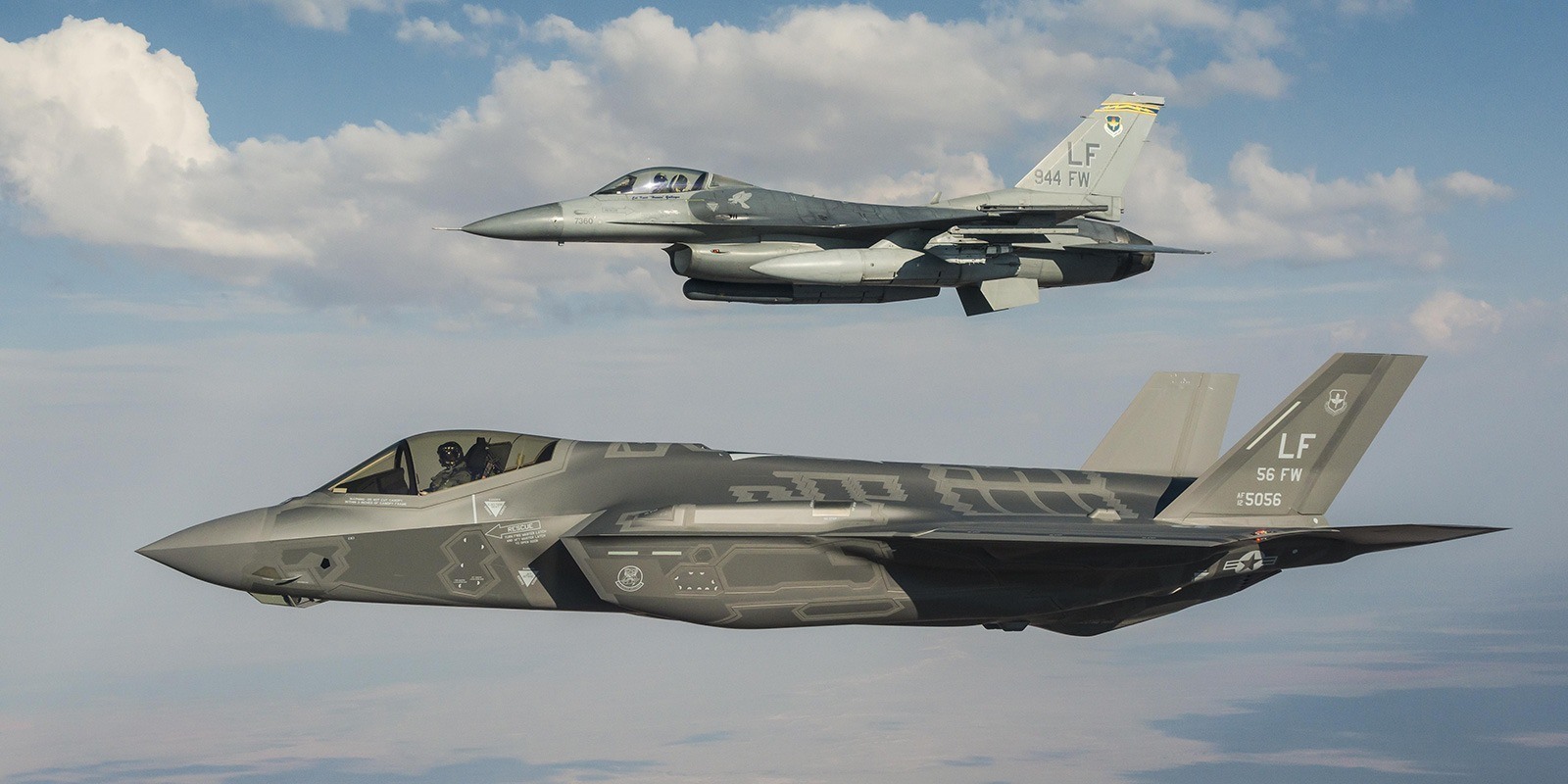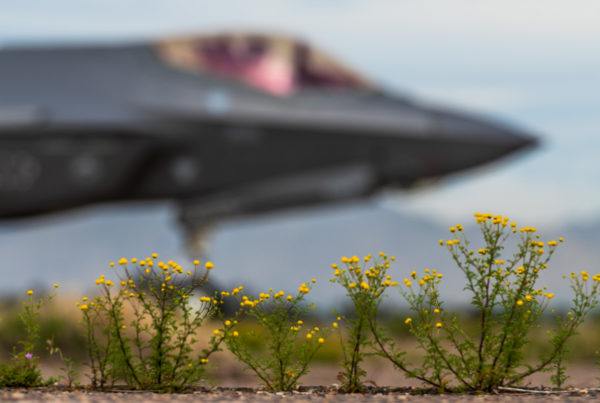Alternative Missions for Luke AFB? Not hardly…
This summer, my wife and I moved to the West Valley after 36 years of commissioned active duty service in the United States Air Force. I have been following with great interest the deliberate planning process for determining the F-35 Lightning II aircraft base assignment; in particular, the issues arising from and by the elected officials and citizens of El Mirage. While it is both impressive and heartwarming to see a large number of people with genuine and unwavering support for the men and women in uniform–and for continuing the vital training missions of Luke AFB–it has also been rather interesting listening to the public discussion on jet noise. Now, the latest notion being put forward is rather than have F-35s at Luke, the community should enter a dialogue with the Air Force on altering the mission of Luke AFB to ones that do not have jet noise. Let me outline why that would be a bankrupt strategy and puts at risk the $2.17 billion of economic impact to the Valley of the Sun and to Arizona.
First on jet noise. There seems to be a significant amount of confusion and misinformation being bandied about at El Mirage town meetings. For example, a group concerned about jet noise visited Eglin AFB in Florida and obtained a recording of aircraft landing at the end of Eglin’s runway and only 100 feet above the ground. They later played those tapes to the citizens of El Mirage at a town meeting with speakers on full blast—of course, it was ear-splitting. Next, they insinuated that is what F-35s will sound like over El Mirage. Nothing could be further from the truth. Yes, you would hear that level of sound if you stood on Northern Avenue at the end of the Luke runway directly underneath jets less than 100 feet overhead. But El Mirage is 4-and-one-half miles from the end of Luke’s runway, and the pattern for flight overhead is not 100 feet but 1,500 feet above ground level. In the upcoming months as part of this deliberate process on F-35 basing, there will be a public release of the actual noise level and contour maps for the surrounding communities. I urge people to wait for the science and the facts; then have productive discussions on the similarities, differences, and impacts of moving from F-16s to the F-35.
As to altering the mission of Luke AFB—an established fighter training base continuously since World War II—let me outline a macro view of the United States Air Force and its specific mission areas, and offer my opinion on which alternative missions might instead come to Luke. The short answer is I see none. It is F-35 or little else. Let me explain.
Our United States Air Force provides to our sovereign nation military effects and power across three domains: air, space and cyber. Cyber is the Air Force’s newest mission and it entails defensive and offensive measures to protect vital computer networks, communication systems, and links so the military would never be blinded by potential enemies and adversaries. Space missions include the Global Positioning Systems (for example, your navigators in your car, golf cart or cell phones use the constellation of Air Force GPS satellites to determine your location and route), early warning, weather, and reconnaissance satellites, and more. Air missions include air dominance and air superiority, global reach, global power including close air support to soldiers on the ground, ISR (intelligence, surveillance, and reconnaissance) and more. The Air Force has six distinctive capabilities it brings to the joint service fight: Air and Space Superiority, Global Attack, Rapid Global Mobility, Precision Engagement, Information Superiority, and Agile Combat Support.
Today, Luke AFB (including its Goldwater Range, Gila Bend, and Auxiliary 1 fields) trains fighter pilots and maintenance personnel and does so from the largest fighter wing in the USAF. Luke AFB directly supports the capabilities of Global Attack, Precision Engagement, and Agile Combat Support and to some degree Air Superiority.
How would Luke fit for other active-duty mission areas and capabilities?
– Cyber missions are headquartered in San Antonio, Texas, with Cyber Wings at Lackland AFB in Texas and Robins AFB in Georgia. While the 56th Communications Squadron at Luke does have the responsibility of implementing directed measures to ensure local computer systems are protected, the headquarters, planning, policy, programming and budgeting of Cyber will come from the Pentagon and San Antonio. I envision no global Cyber missions for Luke.
– Space Command is headquartered at Peterson AFB in Colorado. Satellites are controlled from Schriever AFB in Colorado. On each coast, we have space launch bases—Patrick AFB (Cape Canaveral) in Florida and Vandenberg AFB in California. Los Angeles AF Station manages a majority of the space acquisition programs. I see no Space missions for Luke.
– Nuclear missions are in the Global Strike Command with its headquarters at Barksdale AFB in Louisiana. Nuclear capable bombers are at Barksdale, Minot AFB in North Dakota and Whiteman AFB in Missouri. Global Strike Command also controls the inter-continental ballistic missile forces with missile silos at Malmstrom AFB in Montana, FE Warren AFB in Wyoming and Minot AFB in ND. I envision no nuclear assets at Luke AFB.
– Air Mobility Command provides the strategic and tactical airlift with C-17s, C-5s and C-130 aircraft and the tanker refueling force of KC-135s and KC-10s. While headquartered at Scott AFB in Illinois (adjacent to and part of the US Transportation Command, also at Scott AFB), its bases are logically on the coasts. Eastern ports of embarkation are Dover AFB in Delaware, Charleston AFB in South Carolina and McGuire AFB in New Jersey. Western ports and bases include Travis AFB in California, McChord AFB in Washington, Elmendorf AFB in Alaska and Hickam AFB in Hawaii. Air Mobility Command also maintains an Enroute Structure of bases across the Atlantic, Pacific oceans and into the warzone. C-130s for tactical intra-theater airlift are often co-located next to Army bases like Pope AFB next to Fort Bragg in North Carolina, as well as in the European and Pacific theaters. I see no mobility missions for Luke.
– ISR—Intelligence, Surveillance, and Reconnaissance—involve an array of manned aircraft systems and remotely piloted aircraft (RPA). Robins AFB in Georgia is home to the JSTARS system, Tinker AFB in Oklahoma (as well as Elmendorf Alaska and NATO Geilenkirchen in Germany) is home to the AWACS system. Beale AFB in California houses the U-2 system and the Global Hawk RPA while Predator and Reaper RPA are operated from Creech AFB in Nevada, and soon from Cannon AFB and Holloman AFB in New Mexico. I see no ISR mission for Luke.
– The Air Force’s elite special operations are based at Hurlburt Field in Florida and also at Moody AFB in Georgia and Kirtland AFB in New Mexico. I see no special ops work for Luke.
– Pushing the envelope with a flight test is Edwards AFB across great expanses of flat desert and dry lake beds in California. I see no opportunities for the Flight Test Center at Luke AFB.
– In Air Superiority, think F-22. Training for those fighter pilots is at Tyndall AFB in Florida and the operational bases have already been determined at Langley AFB in Virginia, Holloman AFB in New Mexico, Elmendorf AFB in Alaska and Hickam AFB in Hawaii. The Air Force will only have 186 F-22s and they are all spoken for. None will come to Luke.
– Precision engagement missions are accomplished with F-16s, F-15Es, and A-10s. Luke, Seymour-Johnson AFB in North Carolina and Davis-Monthan AFB in Tucson are the respective fighter training bases for those systems. Active duty A-10 bases include Davis-Monthan, Moody AFB in Georgia, Eielson AFB in Alaska, Osan Air Base in Korea, and Spangdahlem Air Base in Germany. Active duty F-15E are based at Mountain Home AFB in Idaho, Elmendorf AFB in Alaska and RAF Lakenheath in the United Kingdom. Active duty operational F-16 wings are well established at Shaw AFB in South Carolina, Hill AFB in Utah, Aviano Air Base in Italy, Spangdahlem Air Base in Germany, Osan and Kunsan Air Bases in Korea, and Misawa Air Base in Japan. The Air Force has already determined the F-16 and A-10 replacement—the F-35—will have operational wings at bases other than Luke. Eglin AFB in Florida is already designated as a joint training base for the F-35, and Eglin’s proximity facilitates Navy needs. Luke remains in competition for the second training base. That flying training mission is the only one penciled in as a possibility for Luke. Other active bases being considered are Eglin AFB in Florida and Holloman AFB in New Mexico.
The bottom line is Luke’s future is training fighter pilots in the F-35. F-35s at Luke would continue its historical mission, continue the best military-community partnership I have seen across the USA, and from an economic standpoint, continue to provide the $2.17 billion foundation to the West Valley, broader Phoenix, and Arizona’s economy—especially important as we work through these toughest of economic times. The remaining multi-missions of the United States Air Force are well-established at bases and communities and performing superbly. It would be fiscally irresponsible to relocate well-established infrastructure elsewhere for other than mission-essential reasons. It would also ask Peter to pay Paul by uprooting missions from other USA communities. Notions by some to go down those paths of changing the mission of Luke AFB are unrealistic and put much at risk.
Let me close by mentioning several key initiatives involving community leaders and the public, and provide an opportunity to voice support for Luke AFB and the F-35 mission. The Governor, both US Senators, every US Congressman from Arizona, 14 mayors from the Valley’s cities and many more have publicly stated their strong support for the F-35 and for its basing at Luke. If you want to also be heard, I suggest you go to Luke Forward and register. It is free. Today, 11,334 people have registered at that site as supporters of Luke and the F-35. While that is a sizeable number, now is not the time for “The Silent Majority” to be silent—support statistics will be presented to the Air Force team that will visit the Valley over the coming months to evaluate all the factors, including community support.
Another organization and website I call your attention to are Fighter Country Partnership at FighterCountry.org. They have been a viable organization for more than a decade, and organization dedicated to the men, women, families, and mission of the United States Air Force in Arizona. Fighter Country partnership has been at the leading edge with mayors and business leaders to ensure a living partnership, including bedding down the F-35. If you agree that Luke is an important element of the Valley of the Sun, please take a look and be involved—now!
OP-ED by Lt General John F. Regni, USAF (retired)









